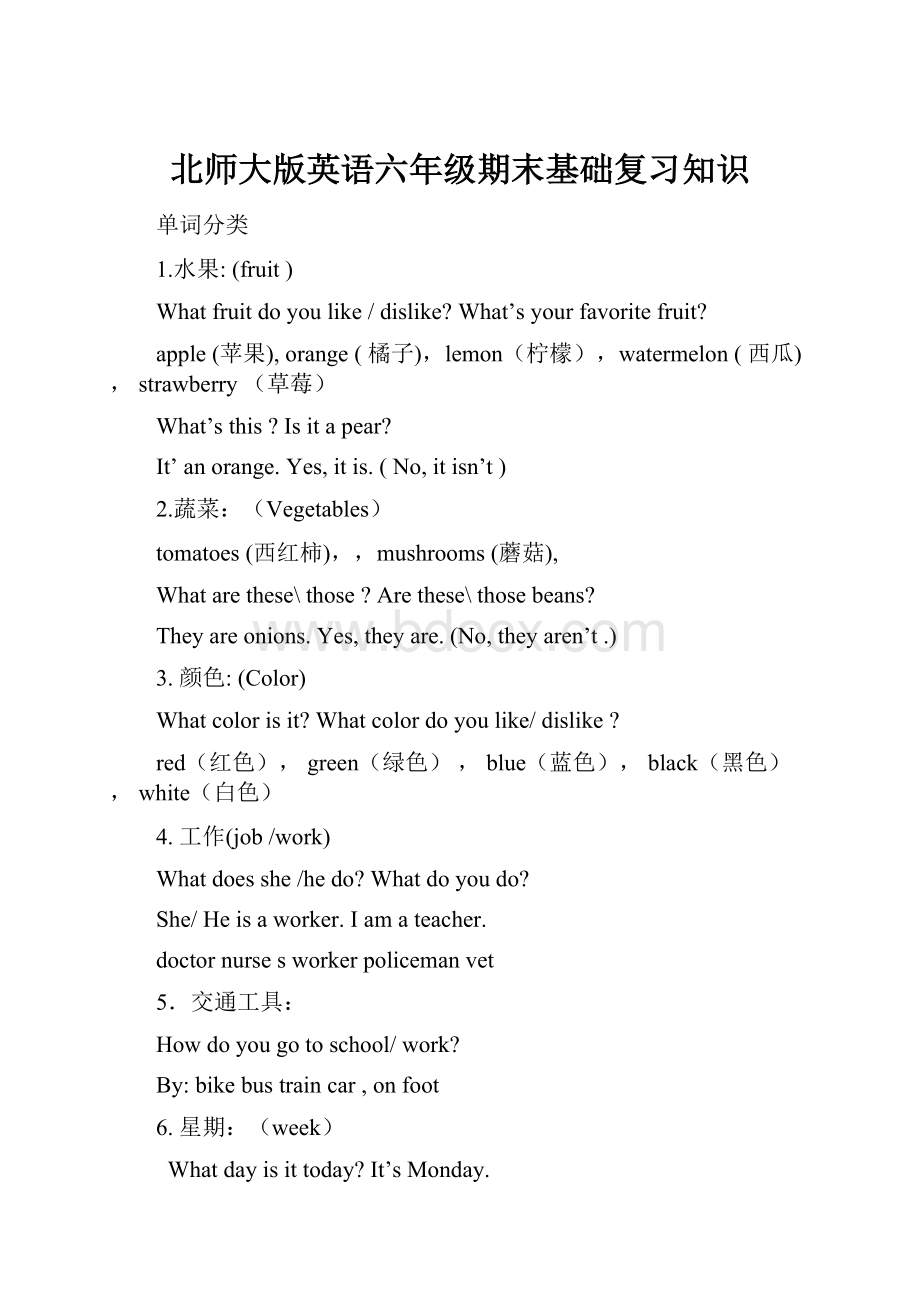 北师大版英语六年级期末基础复习知识.docx
北师大版英语六年级期末基础复习知识.docx
- 文档编号:27592780
- 上传时间:2023-07-03
- 格式:DOCX
- 页数:16
- 大小:26.15KB
北师大版英语六年级期末基础复习知识.docx
《北师大版英语六年级期末基础复习知识.docx》由会员分享,可在线阅读,更多相关《北师大版英语六年级期末基础复习知识.docx(16页珍藏版)》请在冰豆网上搜索。

北师大版英语六年级期末基础复习知识
单词分类
1.水果:
(fruit)
Whatfruitdoyoulike/dislike?
What’syourfavoritefruit?
apple(苹果),orange(橘子),lemon(柠檬),watermelon(西瓜),strawberry(草莓)
What’sthis?
Isitapear?
It’anorange.Yes,itis.(No,itisn’t)
2.蔬菜:
(Vegetables)
tomatoes(西红柿),,mushrooms(蘑菇),
Whatarethese\those?
Arethese\thosebeans?
Theyareonions.Yes,theyare.(No,theyaren’t.)
3.颜色:
(Color)
Whatcolorisit?
Whatcolordoyoulike/dislike?
red(红色),green(绿色),blue(蓝色),black(黑色),white(白色)
4.工作(job/work)
Whatdoesshe/hedo?
Whatdoyoudo?
She/Heisaworker.Iamateacher.
doctornursesworkerpolicemanvet
5.交通工具:
Howdoyougotoschool/work?
By:
bikebustraincar,onfoot
6.星期:
(week)
Whatdayisittoday?
It’sMonday.
Monday(Mon.星期一),Tuesday(Tue.星期二),Wednesday(Wed.星期三),Thursday(Thur.星期四),Friday(Fri.星期五),Saturday(Sat.星期六),Sunday(Sun.星期日)
7.月份:
(month)
January(Jan.一月),February(Feb.二月),March(Mar.三月),April(Apr.四月),May(May.五月),June(Jun.六月),July(Jul.七月),August(Aug.八月),September(Sep.九月),October(Oct.十月),November(Nov.十一月),December(Dec.十二月)
What’sthedatetoday?
It’sJanuary1st.
Whenisyourbirthday?
It’sJanuary12th.
8、季节:
(Seasons)
Spring(春),Summer(夏),Autumn(秋)=fallWinter(冬)
Whichseasondoyoulike?
Ilikespringbecauseit’sgreeneverywhere.
9.Animals动物
cat(猫),squirrel(松鼠),snake(蛇),bird(鸟)zoo(动物园)panda(熊猫)
10.人称
your-你(们)的my-我的she-她he-他
family-家庭mother-妈妈father-爸爸sister-姐姐
brother-兄,弟me-我grandmother-(外)祖母
grandfather-(外)祖父aunt-(婶)姑,姨uncle-叔,伯,舅mom-妈妈dad-爸爸her-她的his-他的friend-朋友boy-男孩girl-女孩children-孩子,儿童it-它teacher-教师
name-名字queen-女王
11.Numbers:
数字
What’syourtelephonenumber?
Howmuchisit?
Howoldareyou?
(1)基数词:
0zero1one2two3three4four5five6six
7seven8eight9nine10ten11eleven
12twelve13thirteen14fourteen15fifteen
16sixteen17seventeen18eighteen19nineteen
20twenty
(2)序数词:
first第一second第二third第三fourth第四fifth第五
sixth第六seventh第七eighth第八ninth第九
tenth第十eleventh第十一twelfth第十二thirteenth第十三
fourteenth第十四fifteenth第十五sixteenth第十六
seventeenth第十七eighteenth第十八nineteenth第十九
twentieth第二十
13.天气状况:
(weather)
What‘stheweatherliketoday?
It’swindy.
cloudy(多云的),rainy(夏雨的)snowy(下雪的),windy(多风的),weather(天气)
14.形状
circle-圆heart-心形,心脏rectangle-长方形,矩形
square-正方形
15.地点场所:
(Places)
trainstation(火车站),,museum(博物馆),amusementpark(游乐场),bedroom(卧室),hospital(医院),
16.运动:
(sports)
football=soccer(足球),basketball(篮球),badminton(羽毛球),tabletennis(乒乓球),volleyball(排球),team(球队),row(排),
17.食物:
(Food)
milk(牛奶),hamburger(汉堡包),,hotdog(热狗),Frenchfries(炸薯条),icecream(冰淇淋)
18.日常用品:
bed(床),sofa(沙发),clock(钟),watch(手表),table(桌子),radio(收音机),lamp(台灯),television(TV)(电视机),photo(照片),,newspaper
19.身体部位:
(body)
face(脸),ear(耳朵),eye(眼睛),head(头),nose(鼻子),mouth(嘴),teeth(牙齿),foot(脚),
20.Subjects(科目)
Chinese语文,English英语,Art美术,Math数学,P.E.体育,puter电脑,History历史,Music音乐,Geography地理,Science科学
21.乐器:
Playthepiano弹钢琴,playtheviolin拉小提琴,
playtheguitar弹吉他,playtheflute吹笛子,Playthedrums敲鼓
23.活动:
(Activities)
takeabusrideabikewalktoschoolreadstorybooksreadnewspapers
乘公共汽车骑自行车步行去学校读故事书读报纸
havebreakfasthavelunchhavedinnergetup(late)gotobedgotosleep
吃早餐吃午餐吃晚餐起床上床睡觉上床睡觉
haveEnglishclassgotoEnglishclass上英语课helpMom帮妈妈干家务
havemusicclassgotomusicclass上音乐课goshopping购物
havedanceclassgotodanceclass上舞蹈课watchTV看电视
haveswimmingclassgotoswimmingclass上游泳课birthdayparty生日聚会
haveartclassgotoartclass上艺术课visitgrandma看望奶奶
haveP.E.classgotoP.E.class上体育课gooutwithfamily和家人外出
haveEnglishcornergotoEnglishcorner参加英语角
gotothesupermarket去超市gotothepark去公园
playwithfriends和朋友们玩gotothebank去银行
gotothelibrary去图书馆gotothemovietheater去电影院
gotoschool去上学
24.学习用品
penpencilpencil-boxbooknotebook
25.衣服clothes
外套,大衣coat,T恤T-shirt,西装suit,
26动词过去式(自己看书)
27.句型:
Don’twalkDon’tlitterDon’ttouchDon’trunDon’tbelateNobikesNocamerasNosmokingNofoodNoparkingNoswimming
28.缩写
I’m=Iamwho’s=whoisthat’s=thatisyou’re=youarewhat’s=whatisisn’t=isnotI’ve=IhaveI’ll=Iwilllet’s=letushasn’t=hasnothaven’t=havenot
29.动词:
(verbs)
run(跑),jump(跳),swim(游泳),play(玩),e(来),go(去),draw(绘画),talk(谈话),sing(唱歌),dance(跳舞),read(读),walk(走),listen(听),see(看见),climb(爬),knock(敲),make(制作),touch(触摸),teach(教),smile(笑),cry(哭),litter(扔),start(开始),laugh(笑),buy(买),mix(混合),add(加),bake(烤),break(打碎),need(需要),pour(倒)
Whatcanyoudo?
Canyouswim?
Icandance.Yes,Ican.(No,Ican’t.)
2019年北师大版英语六年级期末基础复习知识
小学阶段一共学了四种时态,分别是:
一般现在时,一般将来时,现在进行时,一般过去时。
下面我们一一进行总结。
1、一般现在时
A、表示不受时限的客观存在
如:
Heisaboy.Sheisastudent.Mymotherisanurse.
Thisisadog.Ihaveastory-book.
B、表示现在的习惯动作,即指现在经常发生的动作,一般现在时常用来表示现在时间里某种动作的经常性和习惯性。
它常与表示程度或频度的词连用,如:
often(经常),usually(通常,一般),sometimes(有时),always(总是,一直),never(从不)
如:
Ioftengotoschoolonfoot.Myfatherworksinaschool.
MikewatchesTVeveryday.
Iusuallyplayputergamesontheweekend.
C、表示现时的状态和现在瞬间动作
如:
Howareyou?
Youlookhappy.
What’sthematterwithyou?
Ihaveaheadache.
Whatdoyouhaveforlunch?
Ihavesomechicken.
☆注意☆英语动词的现在时与原形同形。
但当主语是第三人称单数时,须在词尾加-s或-es。
例如:
Ihaveafishfordinner.Hermotherworksinahospital.
Amyoftengoestoschoolbybike.Mr.LiuteachesusEnglish.
加-es的动词必须是以“sh,ch,o”等字母结尾的。
如:
watches,teaches,goes,washes
2、一般将来时
表示在将来会发生的事或动作。
它常与表示将来的时间连用,如:
tomorrow,nextweek,nextyear,thismorning,thisafternoon,thisevening等。
☆注意☆一般将来时小学阶段主要学了两种结构:
①begoingto+动词的原形/地点②will+动词的原形
例句:
I’mgoingtogoshoppingthisafternoon.
SheisgoingtoHongKongnextweek.
Youwillseemanybirdsinthesky.
3、现在进行时
表示说话时正在进行的动作或现阶段一直在进行的动作。
☆注意☆它的构成是:
be的现在时形式(am,is,are)加动词的ing形式。
如:
Whatareyoudoing?
I’mwritingaletter.
Whataretheydoing?
They’reswimming.
Isheplayingchess?
Yes,heis.
Look,AmyisreadinganEnglishbook.
☆注意☆动词的ing形式的构成规则:
1一般的直接在后面加上ing,
如doing,going,working,singing,eating
②以e结尾的动词,要先去e再加ing ,如having,writing
③双写最后一个字母的(此类动词极少)有:
running,swimming,sitting,getting
4、一般过去时
主要用来表示在特定过去时间中一次完成的动作或一度存在的状态,也可表示过去的习惯动作。
它与现在时间不发生关系,它表示的动作或状态都已成为过去,现已不复存在。
它经常与表示过去的时间连用。
如:
Iwenttoaparkyesterday.Ireadabooklastnight.
IwatchedTVyesterdayevening.
Iwentonabigtriplastweekend.IfailedmyChinesetest.
☆注意☆ 一般过去时主要体现在动词的形式要用过去式,动词的过去式的构成规则有:
A、规则动词
1一般直接在动词的后面加ed ;
如 worked,learned,cleaned,visited
② 以e结尾的动词直接加d ;如 lived,danced,used
3以辅音字母加y结尾的动词要改y为i再加ed (此类动词较少)如 study–studiedcarry–carriedworry–worried
(play、stay除外)
④双写最后一个字母(此类动词较少)如 stopped
B、不规则动词(此类词并无规则,须熟记)小学阶段要记住以下动词的原形和过去式:
sing–sang,eat–ate,see–saw,have–had,do–did,go–went,take–took,buy–bought,get–got,read–read,fly–flew,am/is–was,are–were,say–said,leave–left,swim–swam,tell–told,draw–drew,e–came,lose–lost,find–found,drink–drank,hurt–hurt,feel–felt
☆注意☆句子的形式:
1、肯定句:
是指用肯定的语气来陈述的句子,如:
I’mastudent.Sheisadoctor.Heworksinahospital.
Therearefourfansinourclassroom.
I’mgoingtobuyaicbooktonight.Hewilleatlunchat12:
00.
I’mreadingabook.Theyareswimming.
IwatchedTVyesterdayevening.
2、否定句:
含有否定词或表示否定意义词的句子,如:
I’mnotastudent.Sheisnot(isn’t)adoctor.
Hedoesnot(doesn’t)workinahospital.
Therearenotfourfansinourclassroom.
I’mnotgoingtobuyaicbooktonight.
Hewillnot(won’t)eatlunchat12:
00.
I’mnotreadingabook.Theyarenot(aren’t)swimming.
Ididnot(didn’t)watchTVyesterdayevening.
☆注意☆小结:
否定句主要是在肯定句的基础上加上了否定词“not”。
有动词be的句子则“not”加在be后面,可缩写成“isn’t,aren’t”,但amnot一般都分开写。
没有动词be的句子则要先在主要动词的前面加上一个助动词(do,does,did),然后在它后面加上“not”,你也可以把它们缩写在一起如“don’t,doesn’t,didn’t)。
这三个助动词要根据人称和时态来选择,其中“does”只用于一般现在时主语是第三人称单数的情况,而“did”只用于一般过去时,不论主语是什么人称和数,都用“did”。
3、一般疑问句:
是指询问事实的句子,此类句子必须用“yes”,或“no”来回答。
如:
Areyouastudent?
Yes,Iam/No,I’mnot.
Issheadoctor?
Yes,sheis./No,sheisn’t.
Doesheworkinahospital?
Yes,hedoes./No,hedoesn’t.
Aretherefourfansinourclassroom?
Yes,thereare./No,therearen’t.
Areyougoingtobuyaicbooktonight?
Yes,Iam./No,Iamnot.(Yes,weare./No,wearen’t.)
Willheeatlunchat12:
00?
Yes,Iwill./No,Iwillnot(won’t).
Areyoureadingabook?
Yes,Iam./No,Iamnot.
Aretheyswimming?
Yes,theyare./No,theyaren’t.
DidyouwatchTVyesterdayevening?
Yes,Idid./No,Ididn’t.
☆注意☆小结:
一般疑问句是在肯定句的基础上,
①把动词be调到首位,其他照写,末尾标点符号变成问号即可。
②没有动词be的句子则要在句首加上一个助动词(do,does,did)再把紧跟在后面的动词变回原形,末尾标点符号变成问号即可。
这三个助动词也要根据人称和时态来选择,其中“does”只用于一般现在时主语是第三人称单数的情况,而“did”只用于一般过去时,不论主语是什么人称和数,都用“did”。
一般疑问句有个重要的原则就是问和答要一致,即问句里的第一个单词(助动词)和简略答句里的这个词是一致的。
4、特殊疑问句:
以特殊疑问词(what,where,who,which,when,whose,why,how等)开头引导的句子。
此类句子应该问什么就答什么,不能用“yes、no”来回答。
如:
Whatisthis?
It’saputer.
Whatdoeshedo?
He’sadoctor.
Whereareyougoing?
I’mgoingtoBeijing.
Whoplayedfootballwithyouyesterdayafternoon?
Mike.
Whichseasondoyoulikebest?
Summer.
Whendoyouusuallygetup?
Iusuallygetupat6:
30.
Whoseskirtisthis?
It’sAmy’s.
Whydoyoulikespringbest?
BecauseIcanplanttrees.
Howareyou?
I’mfine./I’mhappy.
HowdidyougotoXinjiang?
IwenttoXinjiangbytrain.
☆其中how又可以和其他一些形容词连用组成特殊疑问词组用来提问,如:
howmany(多少(数量)),howmuch(多少(钱)),howtall(多高),howlong(多长),howbig(多大),howheavy(多重)
例句:
Howmanypencilsdoyouhave?
Ihavethreepencils.
Howmanygirlscanyousee?
Icanseefourgirls.
Howmanydesksarethereinyourclassroom?
Thereare51.
☆小结:
howmany用来提问可数名词的数量,主要有以上三种句
- 配套讲稿:
如PPT文件的首页显示word图标,表示该PPT已包含配套word讲稿。双击word图标可打开word文档。
- 特殊限制:
部分文档作品中含有的国旗、国徽等图片,仅作为作品整体效果示例展示,禁止商用。设计者仅对作品中独创性部分享有著作权。
- 关 键 词:
- 北师大 英语 六年级 期末 基础 复习 知识
 冰豆网所有资源均是用户自行上传分享,仅供网友学习交流,未经上传用户书面授权,请勿作他用。
冰豆网所有资源均是用户自行上传分享,仅供网友学习交流,未经上传用户书面授权,请勿作他用。


 《贝的故事》教案4.docx
《贝的故事》教案4.docx
